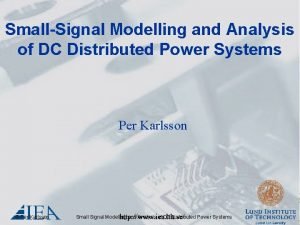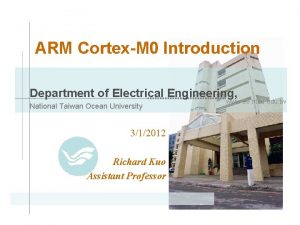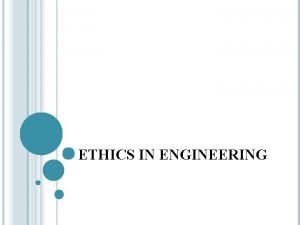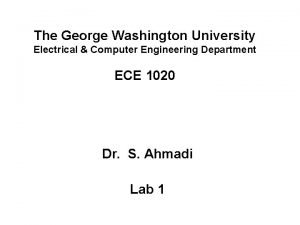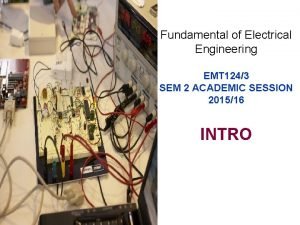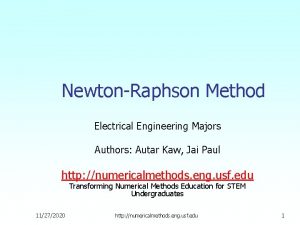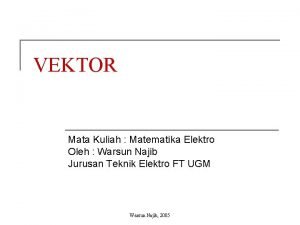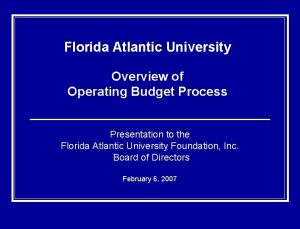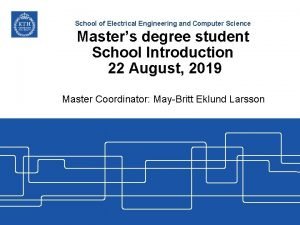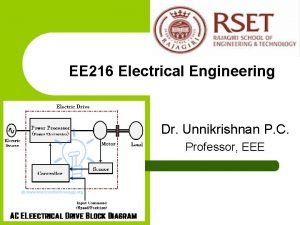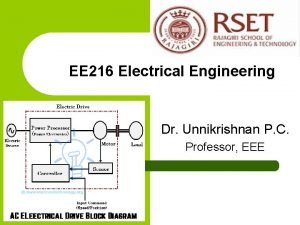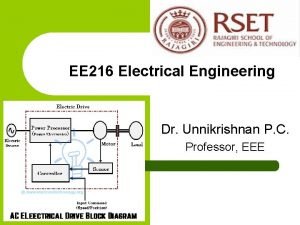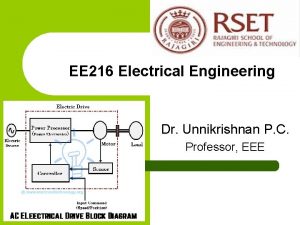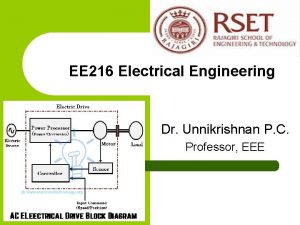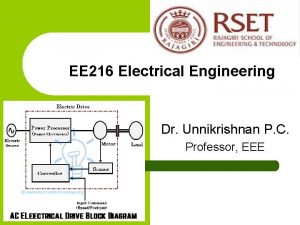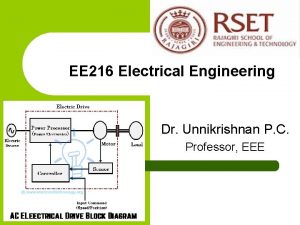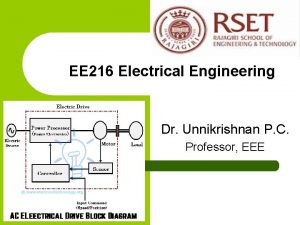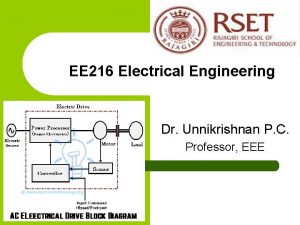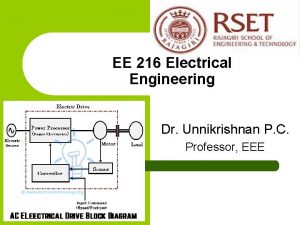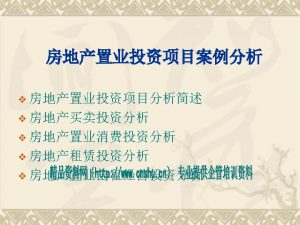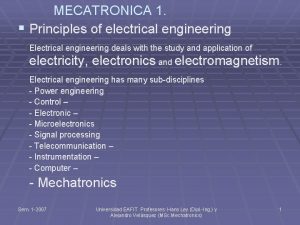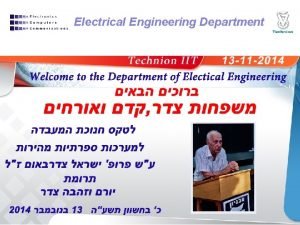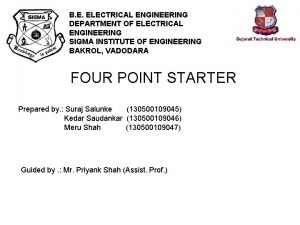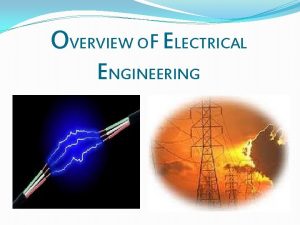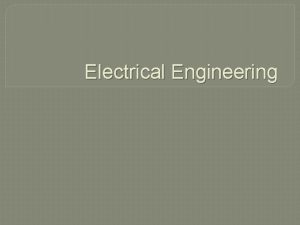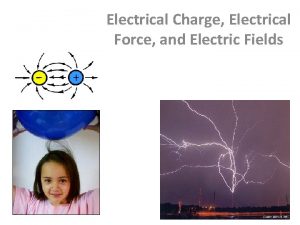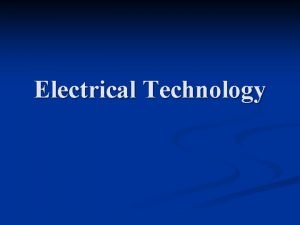EE 216 Electrical Engineering Dr Unnikrishnan P C





























- Slides: 29

EE 216 Electrical Engineering Dr. Unnikrishnan P. C. Professor, EEE

Synchronous Generator-Alternator

Stator Construction • Stator is identical to the induction motor • Laminated low silicon steel rings joined together • Slots insulated with Mylar • Example of 36 slot stator with 3 coil conductors per slot, 12 slots per phase

Stator Construction

Rotor Construction Two Types of Rotor • Salient Pole • Cylindrical

Rotor Construction

Salient-Pole Rotor with brushless excitation

Rotor Construction

Operation as a Synchronous Generator

Equations

• Synchronous Impedance

Phasor Diagram of an Alternator at Lagging pf load

Voltage Regulation A convenient way to compare the voltage behaviour of two generators is by their voltage regulation (VR). •

EMF Method or Synchronous Impedance Method Circuit diagram for open circuit and short circuit test on alternator

EMF Method …… • Equivalent circuit on short circuit

OCC & SCC of an Alternator

EMF Method …… No load induced e. m. f. per phase, Eph can be determined from the equation

EMF Method Advantages & Limitations • Advantage: synchronous impedance Zs for any load condition can be calculated. Hence regulation of the alternator at any load condition and load power factor can be determined. • Limitation: This method gives large values of synchronous reactance. This leads to high values of % regulation than the actual. Hence this method is called Pessimistic method.

MMF Method or Ampere Turn Method • The effect of armature leakage reactance by an equivalent additional m. m. f so that this m. m. f may be combined with the armature reaction m. m. f. • An alternator requires m. m. f. which is product of field current and turns of field winding-two components 1. An m. m. f. necessary to induce the rated terminal voltage on open circuit. 2. An m. m. f. equal and opposite to that of armature reaction m. m. f. • The number of turns in the field winding is not known normally, so the m. m. f. is calculated in terms of the field current itself.


MMF Method ………….








Operation as a Synchronous Motor
 Electrical engineering
Electrical engineering Electrical engineering fundamentals 66712 pdf
Electrical engineering fundamentals 66712 pdf Electrical engineering presentation
Electrical engineering presentation Electrical engineering roadmap
Electrical engineering roadmap Ethics engineering
Ethics engineering Northwestern electrical engineering
Northwestern electrical engineering Electrical engineering technion
Electrical engineering technion George washington university electrical engineering
George washington university electrical engineering University of belgrade school of electrical engineering
University of belgrade school of electrical engineering Asu online ee
Asu online ee Electrical engineering math
Electrical engineering math Basic electrical engineering kulshreshtha
Basic electrical engineering kulshreshtha Fundamental of electrical engineering
Fundamental of electrical engineering Newton raphson method electrical engineering
Newton raphson method electrical engineering Batten wiring
Batten wiring Clemson university electrical engineering faculty
Clemson university electrical engineering faculty Vector electrical engineering
Vector electrical engineering Fau electrical engineering flowchart
Fau electrical engineering flowchart Electrical engineering
Electrical engineering Kfupm ee faculty
Kfupm ee faculty Tel aviv university electrical engineering
Tel aviv university electrical engineering Klipsch school of electrical and computer engineering
Klipsch school of electrical and computer engineering Lina lehn
Lina lehn Deguration
Deguration Electrical engineering notation
Electrical engineering notation Principles and applications of electrical engineering
Principles and applications of electrical engineering Electrical engineering
Electrical engineering Electrical engineering has many subdisciplines
Electrical engineering has many subdisciplines Louisiana tech electrical engineering
Louisiana tech electrical engineering Electrical engineering environmental issues
Electrical engineering environmental issues
